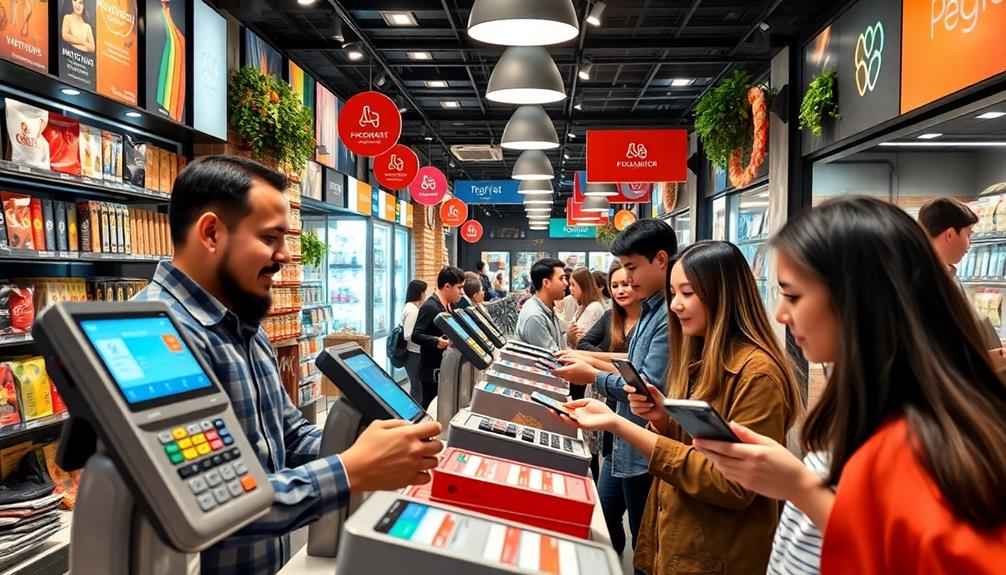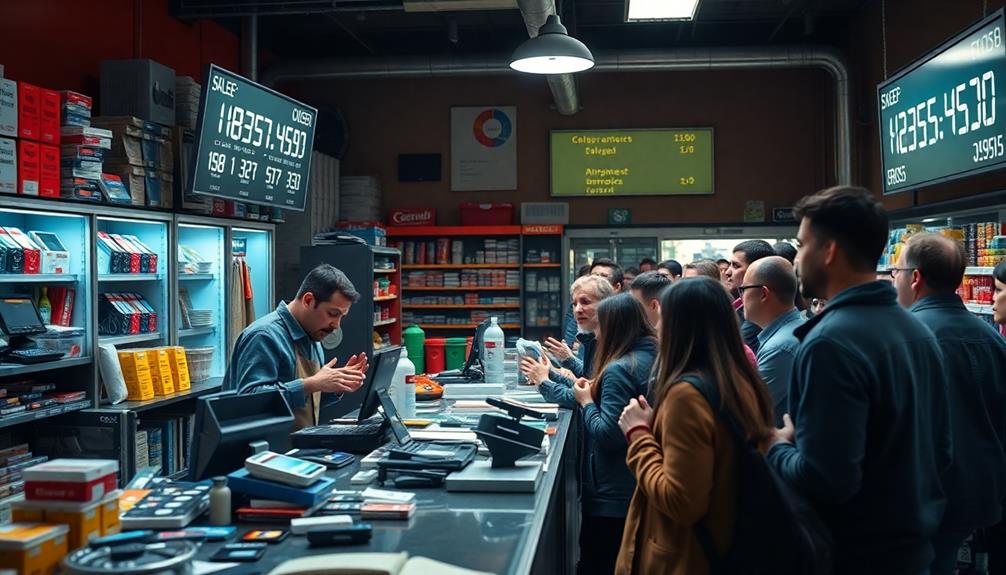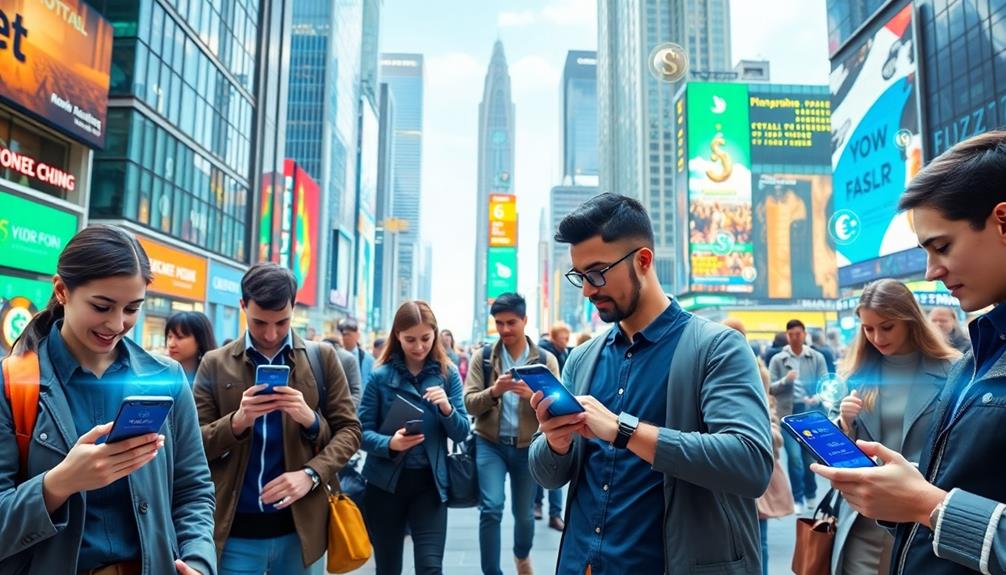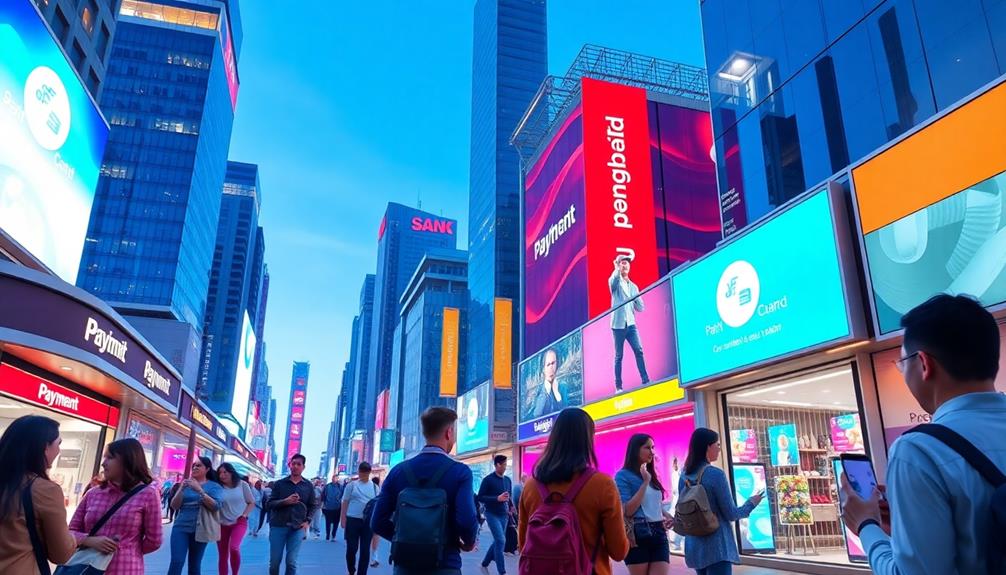Contactless payments are changing the way you do business, with over 40% of in-store transactions in the U.S. already embracing this technology. Most consumers appreciate the convenience, with 90% satisfied and many preferring digital wallets to cash. For you, adopting contactless payments can lead to a 15-20% increase in transaction value and reduced checkout times, enhancing customer satisfaction. However, you'll need to evaluate initial infrastructure costs and cybersecurity measures. Staying informed about trends and consumer behaviors can keep your business competitive in this growing market, and there's much more to discover as the landscape evolves.
Key Takeaways
- Contactless payments accounted for over 40% of in-store transactions in the U.S. in 2023, indicating a significant shift in consumer behavior.
- 70% of U.S. merchants now offer contactless payment options, reflecting widespread acceptance and the need for businesses to adapt.
- Initial investment in contactless payment infrastructure can be high, but benefits include increased transaction values and reduced operational costs.
- Consumer satisfaction with contactless payments is at 90%, making it essential for businesses to prioritize these methods for enhanced customer experience.
- Emerging trends like mobile wallets, biometric security, and cryptocurrency will shape the future of contactless payments, requiring businesses to stay informed and agile.
Current Landscape of Contactless Payments

In today's retail environment, contactless payments have rapidly become the norm, with over 40% of in-store transactions in the U.S. utilizing this technology in 2023. This shift reflects changing consumer preferences, as customers increasingly seek fast, efficient, and secure payment options.
With over 70% of U.S. merchants now offering contactless payment methods, businesses are responding to the rising demand for quicker transaction processing and enhanced security measures. The importance of monitoring credit card statements to catch fraud is heightened as contactless payments grow in popularity, making it vital for both consumers and businesses to remain vigilant.
The global contactless payment market is projected to reach $4.68 trillion by 2027, underscoring its significance in the evolving retail landscape. The adoption of NFC technology allows for seamless mobile payments, ensuring that transactions aren't only swift but also hygienic—qualities that resonate well with today's consumer expectations.
Moreover, the 90% consumer satisfaction rate with contactless payments indicates that shoppers appreciate the convenience and safety this method provides. As half of all in-store transactions in the U.S. are now contactless, it's essential for businesses to adapt and integrate these payment options into their operations.
Embracing contactless payments can enhance customer satisfaction and position your business favorably within the competitive retail market.
Consumer Preferences and Satisfaction

Consumer satisfaction with contactless payments has surged, with 90% of users expressing their approval of this payment method. This high level of customer satisfaction highlights the growing consumer preference for contactless solutions in today's fast-paced world.
Post-pandemic, 79% of Americans perceive contactless payments as more hygienic, further shifting preferences toward safer transaction methods. Additionally, the ease of use associated with contactless payments contributes considerably to financial health, as consumers are more likely to stick to their budgets when transactions are swift and simple efficient budgeting practices.
The convenience and speed of these digital solutions have made them the favored choice over traditional cash handling. With 95% of consumers often leaving their wallets at home, businesses must adapt to this digital payment trend to meet evolving expectations.
Notably, contactless transaction volumes have skyrocketed, accounting for over 40% of in-store payments in 2023. This considerable increase signals a strong consumer shift towards these modern payment methods, showcasing the importance of prioritizing customer satisfaction.
As a business owner, recognizing these trends can help you tailor your services to better align with consumer preferences. By embracing contactless payments, you not only enhance the convenience of transactions but also position your business to thrive in an increasingly digital marketplace.
Benefits for Merchants

Numerous benefits await merchants who embrace contactless payment systems. By integrating these modern payment options, you'll likely see an increase in sales, with transaction values rising by 15-20%. This significant revenue boost comes alongside the reduction of checkout times, which can enhance customer satisfaction and encourage repeat visits.
Moreover, contactless payments minimize cash handling, helping you lower operational costs and reduce the risk of theft associated with traditional payment methods. With over 70% of U.S. merchants adopting contactless payments, not offering this option may risk losing customers to competitors.
Here's a quick breakdown of the benefits:
| Benefit | Impact on Business | Customer Experience |
|---|---|---|
| Increase Sales | 15-20% jump in transaction values | Faster transactions encourage spending |
| Enhance Customer Satisfaction | 90% consumer satisfaction | Convenience leads to repeat visits |
| Reduce Checkout Times | Streamlined payment process | Less waiting time boosts satisfaction |
Challenges for Businesses

Shifting to contactless payment systems presents several challenges for businesses. One major hurdle is the initial investment costs associated with upgrading your payment infrastructure to accept contactless payments. This can be particularly intimidating for small businesses, which may struggle to allocate funds for new technology.
Additionally, businesses might also encounter complications similar to those faced by pet owners when selecting the right dog names that reflect their brand identity.
Additionally, consumer education is vital. Many customers mightn't know how to effectively use contactless payment options, leading to confusion at checkout. You'll need to invest time and resources in educating your customers about the benefits and usage of contactless technology.
Cybersecurity concerns also loom large. You must guarantee robust data protection measures are in place to safeguard customer information during contactless transactions. Failure to do so could result in severe repercussions, including loss of trust and legal issues.
Moreover, limited regional acceptance of contactless payments can hinder widespread adoption and reduce customer convenience. In some areas, infrastructure improvements are necessary to support the effective implementation of this technology, especially in rural regions.
Addressing these challenges will be essential for your business to thrive in the evolving landscape of payment options.
Future Trends in Payment Technologies

As businesses work through the challenges of adopting contactless payment systems, they're also keeping an eye on the future of payment technologies. The global contactless payment market is projected to reach $4.68 trillion by 2027, highlighting a significant growth trend in digital transaction methods. With mobile wallet usage on the rise, you'll likely see an increase in wearable payment technology, such as smartwatches and fitness trackers, making transactions even more convenient.
Moreover, biometric authentication like fingerprint and facial recognition is set to enhance security, boosting consumer confidence in contactless payments. Retailers are also focusing on frictionless shopping experiences, pushing for the rise of checkout-free stores, which are expected to exceed 12,000 by 2027.
Here's a snapshot of these trends:
| Trend | Impact on Businesses | Consumer Benefits |
|---|---|---|
| Mobile Wallet Usage | Increased sales | Convenience and speed |
| Biometric Authentication | Enhanced security | Peace of mind |
| Cryptocurrency | New revenue streams | More payment options |
| Checkout-Free Stores | Streamlined operations | Time-saving shopping |
Embracing these trends will position you for success in the evolving payment landscape.
Frequently Asked Questions
What Is the Future of Contactless Payments?
The future of contactless payments is bright. You'll see increasing adoption, driven by consumer demand for convenience. As technology advances, expect faster transactions and enhanced security, making it easier for you to shop seamlessly.
What Are the Challenges of Contactless Payment?
You'll face several challenges with contactless payments, including high initial costs, consumer education gaps, cybersecurity concerns, limited acceptance in certain areas, and the need for infrastructure improvements, especially in rural locations where resources are scarce.
What Are the Opportunities of Contactless Payments?
Imagine a world where transactions glide smoothly, like a dancer's effortless steps. You'll find opportunities in contactless payments, boosting sales, enhancing customer experiences, and streamlining operations. Embrace this trend to thrive in a modern marketplace.
What Are Two Benefits to Retailers of Accepting Contactless Payments?
Accepting contactless payments speeds up checkouts and boosts customer satisfaction. You'll also see higher transaction values, which can increase overall sales. Plus, it reduces cash handling costs and minimizes theft risk for your business.
Conclusion
As contactless payments continue to gain traction, it's clear that adapting to this trend is essential for your business. By embracing these technologies, you're not just keeping up with the times—you're staying one step ahead. Remember, the early bird catches the worm; seizing this opportunity can enhance customer satisfaction and drive sales. Don't let hesitation hold you back—dive into the future of payments and watch your business thrive in this fast-paced landscape!










